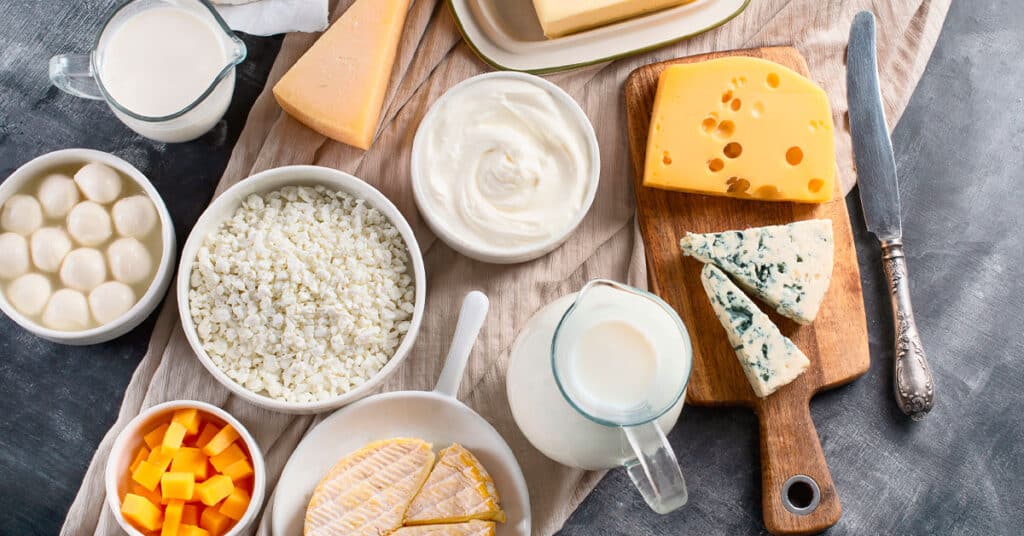

Beginning a whole food, plant-based diet can be challenging, especially when it comes to dairy. Dairy products are in many of the foods we are used to eating on the Standard American Diet. Dairy is in cheese, milk, sour cream, salad dressing, ice cream, and yogurt, just to name a few. However, there are many healthy, plant-based alternatives to all of these foods, and quite a few useful tips and tricks for incorporating them into your diet. Here are Chef Katie’s top tips for ditching dairy.
This may seem like an unusual first step, but identifying the key dairy foods you enjoy will help you
discover new, plant-based options. Some people may enjoy cheese and sour cream the most. While
others prefer sweeter treats like ice cream and Greek yogurt. Keep a food log of your top dairy foods.
Then, as you find healthy alternatives, add these notes to your log.
This food log will help you in two ways. First, it becomes a quick-reference guide for dairy alternatives. Second, you can check your progress as you wean yourself off your old foods. This will be encouraging as you document the changes you’ve made.
Replace Texture and Richness—Not Just Foods
When dairy is used in traditional cooking, it is often used to enhance texture and richness. Rather than focusing on how to find a “vegan cream” to replace traditional heavy cream, focus on how that cream is used in a recipe. Some common ways dairy is used in traditional recipes include:
Creaminess – Cream, butter, and cheese are added to savory dishes to enhance the creamy texture. They appear in mashed potatoes, creamed soups, and cheese sauces. To replicate that savory, creamy texture, you can use soaked cashews, pureed beans, pureed tofu, aquafaba (from canned chickpeas) and mashed potatoes and yams.
Richness – Dairy products can be used to garnish dishes and add rich, fatty flavor. It happens when Parmesan cheese is sprinkled over pasta, sour cream is added to a baked potato, and melty mozzarella is added to pizzas and panini sandwiches. Replace these rich ingredients with plant-based alternatives. Nutritional yeast flakes and hemp hearts can replace Parmesan. Avocado or hummus can be used instead of sour cream. Spread hummus onto a pizza or a sandwich instead of cheese.
Umami Flavor – Umami is a deep “fifth flavor” that you find in dairy, especially in aged cheeses. Umami comes from glutamates. These glutamates can also be found in plant-based foods like nutritional yeast, soy sauce (or tamari), fermented foods, and mushrooms. Cooking with these ingredients will help add umami flavor, without the dairy.
Sweet Creamy Treats – Besides savory foods, traditional dairy shows up in the sweet desserts many Americans love. Ice cream, milkshakes, fudge sauce, frosting, and yogurt parfait are all examples of sweet treats using dairy. However, there are plenty of vegan alternatives to these foods. Frozen bananas can be pureed for “Nice” Cream. Frozen fruit and almond milk can be blended for a smoothie bowl. Dates, cashews, chia seeds, and plant-based milks can be combined to make creamy sauces, cashew frostings, and chia pudding parfaits.
| Profile | Traditional Dairy | Plant-Based Alternatives |
|---|---|---|
| Savory Creaminess | Cream, Butter, Cheese | Soaked Cashews, Pureed Beans, Tofu, Aquafaba, Mashed Potatoes or Yams |
| Richness | Parmesan Cheese, Sour Cream, Sliced Cheese (on Sandwiches) | Nutritional Yeast Flakes, Hemp Hearts, Avocado, Hummus |
| Umami | Aged cheese Cheese Sauces | Nutritional Yeast Flakes, Soy Sauce (or Tamari), Fermented Foods, Mushrooms |
| Sweet Creamy Treats | Ice Cream, Milkshakes, Fudge Sauce, Frosting, Yogurt | Frozen Banana “Nice” Cream, Smoothies, Date Chocolate Sauce, Cashew Frosting, Chia Pudding Parfait |
When starting a plant-based diet, it may be easy to simply replace your traditional dairy foods with processed vegan alternatives. Many supermarkets are happy to offer vegan cheeses, dressings, and sauces. However, it’s worth taking a moment to double-check the label.
Many of these ready-made substitutes are full of refined oils, processed thickeners, and artificial flavors. From a chef’s perspective, such ingredients often leave an unpleasant aftertaste. Tapioca starch tends to stick to the roof of your mouth. Refined oil can taste greasy. Read the labels, and try to avoid these processed ingredients. Remember, it’s not just about finding replacements. Rather, it’s about replacing the texture and richness you crave.
This will help you have more delicious food. Plus, choosing more whole food products will help you stay healthy and satisfied.
One of the best attributes of plant-based cooking is that it is much more freezer-friendly and shelf-stable than food made with traditional dairy. While traditional dairy products can spoil in the fridge, plant-based almond milk can last for months in your pantry. Parmesan cheese may get moldy after a few weeks. However, cashew “Parm” can last for months in your freezer.
When you’re shopping, stock up on the dairy-free staples that you’ll need often. Keep a good supply of plant-based milk, nutritional yeast, nuts, seeds, and canned beans on hand. When you’re making a recipe for a vegan cheese or creamy sauce, make extra. Keep some in the freezer for back-up and emergency meals.
Remember these tips for ditching the dairy in your diet. By starting to adopt a whole food, plant-based diet, you will start to feel better. Experiment with the recipes and ingredients that work best for you. Keep your mind open and your taste buds ready. Enjoy the new flavors. Continue to make time for your health.
Copyright 2025 Center for Nutrition Studies. All rights reserved.